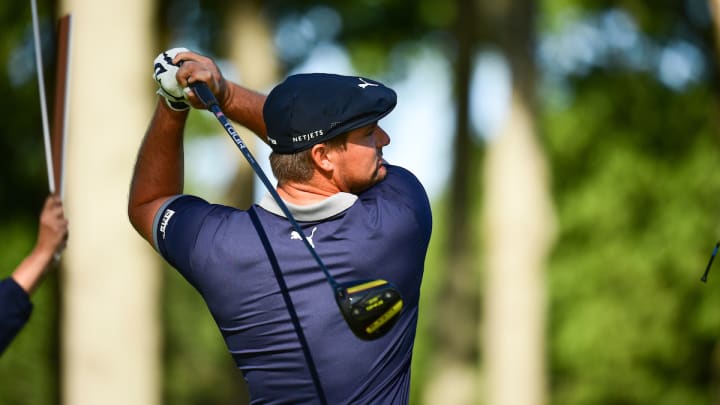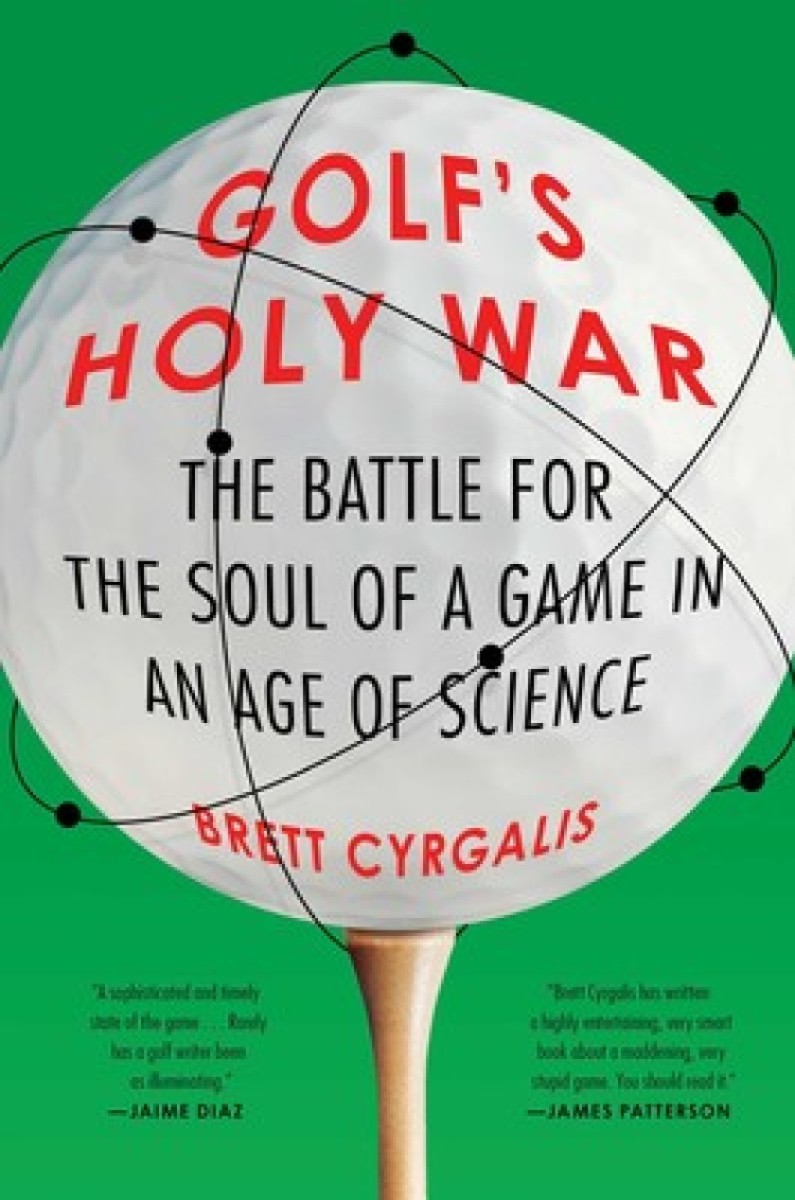Brett Cyrgalis navigates 2 streams of golf instruction

When sportswriter Brett Cyrgalis was covering hockey full-time for the New York Post, he managed to keep his golf game intact, playing to a 3-handicap. Once the hockey season concluded, Cyrgalis whittled the handicap back down to scratch. Given that he's barely taken 10 lessons in his life, it's a bit surprising that his book, "Golf’s Holy War: The Battle for the Soul of a Game in an Age of Science," is about two distinct schools of golf instruction.
The book is ananecdotally rich narrative easily summarized as the skirmish between technology versus intuition. Published in hardback after COVID-19 quarantining ramped up in 2020, "Golf’s Holy War" soon will be released in paperback form. Via Zoom, Cyrgalis and Morning Read contributor Tom Bedell discussed the book and a wide range of topics related to golf instruction.

Morning Read: Who came up with the title?
Brett Cyrgalis: I had it right away. I think golf is the platform for this big question about the world we live in … the question of modernity, whether we embrace or resist technology. Yes, of course, it’s about golf, but I hope readers can pull something out of it that applies to other facets of life: Do you think the world is inherently solvable or mysterious? And how do you deal with that, with all the data now at our fingertips?
MR:You cram a lot in, including references to Sigmund Freud, William James, Babe Ruth and any number of golf instructors and players.
BC: There’s a lot of Tiger [Woods] – and Sean Foley – because Tiger came of age during this transitional period of technological boom, and he’s been the best at balancing it. He has gone the TrackMan route and teachers who led him through different scientific avenues. But he’s always balanced that with the artistic and intuitive side. That’s why he’s so good.
MR: Are any pros purely feel players anymore?
BC: Everyone will tell you they are. No one is going to say, “I’m a technical robot.” But I think every good player in the history of the game has been a little bit of both. Go back to Bobby Jones. Though the game was so different then, he still had an understanding of his own mechanics. Go down the line to [Ben] Hogan, still the deity. There wasn’t any science per se about what he was doing. He just understood his own mechanics so well and practiced so diligently that it started down the avenue of what would become science.
MR:You note Ben Hogan, saying his book, "Five Lessons: The Modern Fundamentals of Golf," would ruin the everyday player. How so?
BC:It’s a tutorial on how to slice. "Five Lessons"is a terrible instructional book. But everybody read it. I took it to pieces when I was in high school. I absolutely loved it. But the stuff that goes around about Hogan and his “secret” is priceless. When the secret is simply practice. There is no secret. But everyone wants there to be a secret, something to hold onto, something tangible. So if Hogan cupped his left wrist, then if I can just cup my left wrist I’ll win nine majors. But it doesn’t work like that.
MR: You arrange your book around two others, Homer Kelley’s "The Golfing Machine" and Michael Murphy’s "Golf in the Kingdom."
BC: When you head down the two avenues of art and science you hit bedrock with these two books. Not many have heard of "The Golfing Machine," but you’d be surprised at its influence. It’s brutally dense, just about impossible to understand, but it physically explains everything. People who really dive into it love it.
MR: And that’s kind of where you distill Bobby Clampett’s career down to one hole.
BC:He was leading the 1982 Open Championship by seven strokes with 31 holes to play, and he fell apart on one hole. And that was basically it, the end of his career right there. He won some satellite event on the PGA Tour, but that was it: one victory. A three-time All-American, two-time college player of the year. It’s unfathomable. Because he just became a bit obsessed with this and maybe a little stubborn about adapting. If you look at Bryson DeChambeau, who uses "The Golfing Machine," he seems a little more willing to adapt, which is why I think he’s been able to sustain a little better. Plus the technology is better so he has more concrete evidence of what he’s doing.

MR: He does seem like a techno geek.
BC: He’s fascinating. I don’t know if he can keep it up playing like this, but I think he’s great for the game because people who are inclined to think that way will be drawn to him, I hope. I wish he were a little more personable but that’s probably just the reporter in me.
MR: On the other spectrum is "Golf in the Kingdom."
BC: Which is way more popular, though if you polled the average golfer, “Are you more into science or the spirituality of the game?” everyone would probably say science, right? But people are drawn to the book because it verbalizes some things they can’t summon up about why they’re drawn to the game. Mention the book to some people — like Sandy Tatum, the former USGA president — they just absolutely love it. It’s a fantastical, philosophical weaving, mystical narrative about Murphy going on this trip to Scotland, which he actually did, though he didn’t meet anyone like Shivas Irons.
MR:Your book should appeal to anyone who has ever taken, is pondering, or is fearful of golf lessons. In other words, most of the golfing population. Yet I note a blurb from Brandel Chamblee, which may throw more fuel on fires he’s started: “... PGA Tour practice facilities are crowded with theorists, pseudo-scientists and teachers, making [them] not a place of discovery, but of danger.”
BC:Brandel is a really smart guy, really well read, and he understands the game really well. He created a stink by basically saying things like the Golf Digest’s 50 Best Teachers list was bullshit, a popularity contest. It’s easy to understand why magazines come up with such lists — to create interest and debate. But they’re all subjective, and Brandel is honest enough that he says stuff like that and people get all alarmed.
MR:One of the more intriguing episodes of the book is how Mike Hebron, the 1991 PGA National Teacher of the Year and a "Golfing Machine" advocate, transformed into more esoteric waters once he questioned the very nature of how humans learn.
BC:I think he’s the best teacher in the country, or the world. He’s brilliant but he goes his own way, and so against what everyone wants these days – “give me my TrackMan numbers,” “give me my video, my biomechanics, my 3D motion analysis.” And none of it makes you any better. Well, maybe it does for some, but as Hebron puts it, that’s not really how your brain learns.
You can’t possibly think of everything your body does while you’re swinging – which is what The "Golfing Machine" does and why it cripples people. You can work on it on the range, but when you actually get over a shot you need to be able to act instinctively, subconsciously.
MR:Still, you don’t really come down on one side or the other.
BC:That was the goal. I’m often asked, “Which side do you fall on?” and I’m happy that that’s not clear.
MR:Because life is ambiguous?
BC: [Laughs.] Well, that’s very meta of you, but yes, I think there’s value in both sides, I really do. I might lean more to the artistic side, but it doesn’t really matter where I lean. I just wanted to present what I found, and let readers figure it out for themselves.
